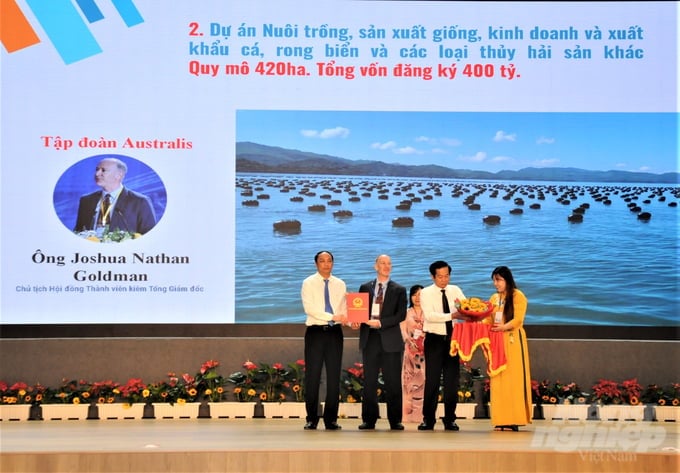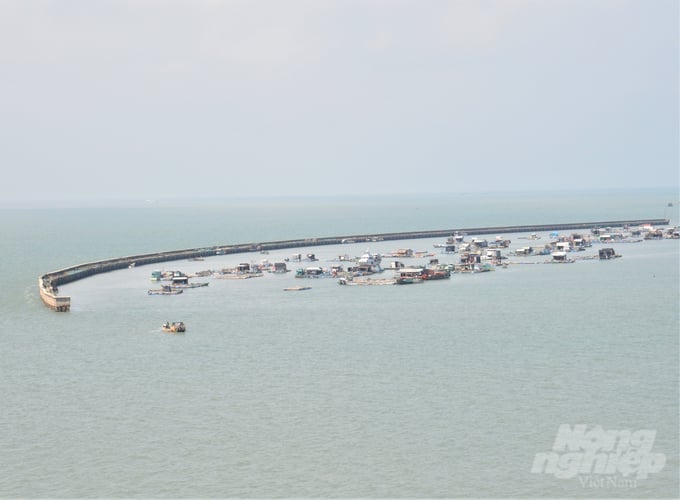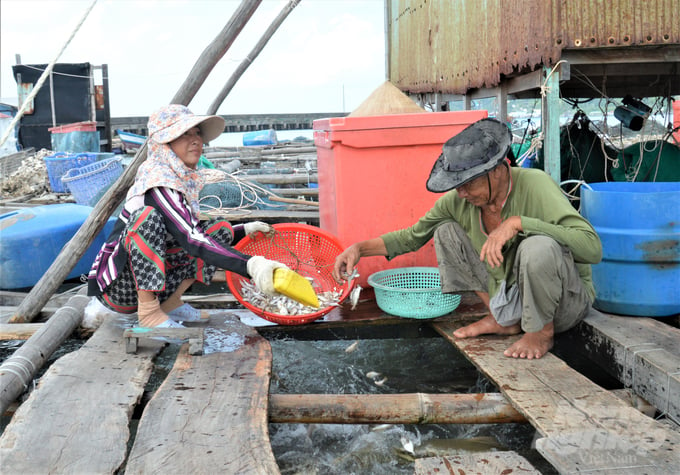May 29, 2025 | 03:17 GMT +7
May 29, 2025 | 03:17 GMT +7
Hotline: 0913.378.918
May 29, 2025 | 03:17 GMT +7
Hotline: 0913.378.918

The leadership of Kien Giang province providing Australis Group with the investment policy to carry out a project on the farming, seed production, trading, and export of fish, seaweed, and other aquatic products. Photo: Trung Chanh.
Kien Giang province possesses a strategic location for the development of the fisheries sector within the Mekong Delta region and the country as a whole. The province benefits from favorable natural conditions, featuring extensive tidal flats and multiple sheltered marine areas that are home to high-value aquatic species. These features are highly conducive to the conservation, development of marine resources and mariculture, particularly the practice of cage fish farming in marine and island environments.
In addition to coastal and inland mariculture, Kien Giang is allocating resources to the development of offshore mariculture and mariculture in open waters. This focus aims to fully utilize the province's potential and advantages for mariculture development, and establish Kien Giang as a marine economic powerhouse within the country in accordance with the recently issued provincial planning.
During the Kien Giang Investment Promotion Conference and the Kien Giang Provincial Planning Conference for the years between 2021 and 2030, with a vision towards 2050, the province's leadership provided major corporations and businesses in the aquaculture sector with numerous investment policies and mariculture projects. They possess strong financial capacity and the ability to adopt advanced technologies in mariculture, with modernized farming processes.
Le Huu Toan, General Director of Kien Giang province's Department of Agriculture and Rural Development, reported that the province has, to date, granted investment policies for mariculture to Australis Aquaculture Vietnam Company Limited, Mavin Group Joint Stock Company, Duc Truong Investment and Development Joint Stock Company, and Bat Ngoc Agricultural Development Joint Stock Company, with a total registered development marine surface area of over 2,608 hectares.
Following their implementation, these projects will contribute to promoting socio-economic development, increasing the province's aquaculture yield, and attracting tourists to the region.
In addition, Kien Giang province is currently managing several effective and ongoing projects, including cage fish farming, seaweed farming, and pearl oyster farming. These projects have been assigned to Ngoc Hien Phu Quoc Pearl Company Limited, Tran Phu Import-Export Trade Service Company Limited, and Hien Cong Company Limited.
Among these entities, the project belonging to Mavin Group is the largest in terms of scale, with several thousands hectares of marine surface area. In addition to planning large-scale mariculture investment, Mavin Group applies modern European farming technology to produce high-quality marine fish for domestic consumption and export.

Businesses investing in mariculture in Kien Giang province require assistance in addressing challenges regarding marine surface area allocation in order to promptly implement their projects. Photo: Trung Chanh.
Mavin Group's project in Kien Giang province is projected to produce approximately 30,000 tons of marine fish per year, which include economically valuable species such as sea bass, grouper, and golden pompano. This mariculture project aims to meet export demands, with a focus on environmental control and traceability to facilitate seafood exports; and compliance with the European Commission's recommendations on illegal, unreported, and unregulated (IUU) fishing prevention.
Additionally, Mavin Group plans to survey and invest in a marine seed center, an aquatic feed production plant, and a seafood processing plant for export.
These investments will enable the company to establish a closed-loop aquaculture chain from breeding and feed production to farming and processing seafood for export, all within one region. Furthermore, the aquaculture chain will help optimize production processes and product costs, thereby contributing to Kien Giang's development as a major center for mariculture and export seafood processing in the region.
General Director Le Huu Toan emphasized that in order to utilize the local potential and advantages for marine economic development, the province regularly reviews, supplements planning, and issues implementation plans for development tasks. In 2020, Kien Giang Provincial People's Committee approved a project for sustainable mariculture development within the province until 2030.

Kien Giang province has approved the project for sustainable mariculture development until 2030 in order to utilize the advantages of its expansive marine areas. Photo: Trung Chanh.
The project aims to promote the rapid development of mariculture in an industrial and modern direction, with a focus on maintaining ecological sustainability, enhancing tourism, and contributing significantly to the restructuring of the province's agricultural sector. Additionally, the project will enhance competitiveness, boost marine economic growth, and increase incomes for local residents.
Kien Giang's mariculture areas are located around the islands of Kien Hai district, Phu Quoc city, several island communes within Kien Luong district, and Ha Tien city. In 2020, the province housed a total of 4,000 aquaculture cages, with a yield of 3,662 tons. Although this figure has decreased to 3,870 by 2023, their scale has increased; and many traditional cages have been replaced with modern models, resulting in a higher yield of 3,910 tons of various fish species. The main farmed species include cobia, grouper, golden pompano, and barramundi.
From 2022 to 2023, Kien Giang province's Agricultural Extension Center has developed and implemented models to support the transition from traditional cages to HDPE cages. As a result, 69 cages, with a total volume of 3,531 cubic meters, have been successfully converted. The utilization of HDPE cages features several benefits, including promoting the environmentally friendly, risk-free, increased yield, and profitable growth of cage mariculture in Kien Giang.

Kien Giang province supports fishermen in their transition from traditional cages to modern HDPE cages; and replacing trash-fish feed with industrial feed to reduce environmental pollution and protect aquatic resources. Photo: Trung Chanh.
In addition to developing mariculture, Kien Giang boasts advantages in coastal, island, and inland aquaculture, featuring diverse species such as bivalve mollusks, pearl oysters, shrimp, crabs, and fish. Notably, the province's mollusk farming area reached nearly 22,000 hectares in 2020, with a total yield of nearly 63,000 tons. By 2023, the farming area has increased to over 23,000 hectares, with a total yield of more than 96,000 tons.
Blood cockles, suberenata ark, sea mussels, green mussels, and undulated surf clams are farmed in the coastal areas of An Bien, An Minh, Hon Dat, Kien Luong, and Ha Tien. Primary farming methods include seeding on tidal flats; and using stake, net, and hanging systems.
Kien Giang's total seafood yield reached over 798,300 tons in 2023, which includes 361,100 tons from aquaculture, valued at over 20,245 billion VND. This is an increase in terms of yield compared to the corresponding period in previous years.
Kien Giang province will continue to invite major corporations and businesses to invest in high-tech, industrial mariculture and offshore farming, with various incentives to attract further investment. Additionally, the province will implement special policies to support the transition from coastal fishing to aquaculture, from traditional cage farming to modern cage farming using industrial pellet feed, with a focus on promoting the sustainable mariculture value chain.
Translated by Nguyen Hai Long
/2025/05/25/4127-3-073637_820.jpg)
(VAN) Thanks to the promotion from an FAO-implemented project, vegetable production in greenhouses in Moc Chau has seen strong development, from 1.5 hectares in 2021 to nearly 50 hectares in 2024.

(VAN) FAO has recently supported USD 140,000 to implement the project 'Risk mitigation human-animal interface risks through disease control initiatives in pig farming.'

(VAN) The People's Committee of Tra Vinh province has approved an adjustment to the investment policy for the Green Hydrogen Plant project, increasing its area to approximately 52.76 hectares.
![Reducing emissions from rice fields: [2] Farmers’ commitment to the soil](https://t.ex-cdn.com/nongnghiepmoitruong.vn/608w/files/news/2025/05/05/dsc08881jpg-nongnghiep-140632.jpg)
(VAN) Clean rice cultivation model in Thuong Tan commune, Bac Tan Uyen district, is assisting local residents in achieving sustainable agriculture by substantially reducing costs, increasing productivity, and protecting the environment.

(VAN) At the conference to disseminate Resolution No. 68, AgriS introduced its digital agricultural ecosystem and reaffirmed its commitment to accompanying the Government in promoting private sector development and sustainable agriculture.

(VAN) 'Blue Ocean - Blue Foods' initiative is designed to restore marine ecosystems and establish sustainable livelihoods for local communities by cultivating a minimum of 1,000 hectares of cottonii seaweed in the first three years.
/2025/05/21/4642-3-112707_603.jpg)
(VAN) The V-SCOPE project has made direct contributions to three out of six pillars of the Comprehensive Strategic Partnership between Vietnam and Australia.